Technology Begets Technology. I’ve been staring at this banner at the DARPA Robotics Challenge for what feels like a solid minute, trying to figure out what the hell it means.
Technology begets technology. Is the banner missing a word? Is it a warning? Technology begets technology. It almost sounds like a threat. If nothing else, it’d certainly make a good slogan for a fascist robot’s presidential campaign one day. And if DARPA has its way, that day could be closer than we think.
Twenty-four teams have come to Pomona, California to compete for their share of $US3.5 million in prize money. They have brought their robots, which are supposed to complete basic tasks like driving and walking in a simulated disaster scenario. The teams control their robots wirelessly from a garage about a quarter of a mile away, and they can only see what the robot sees. It would be an understatement to say that these robots, even with the aid of their brilliant inventors, are not good at doing things that are relatively easy for humans. Not yet, anyway.
The DARPA Robotics Challenge is either the Super Bowl for Nerds or Robot Woodstock, depending on where you get your news. But more fundamentally, it’s an advertisement for DARPA. This is arguably the most high profile, public-facing event that DARPA has ever put on. And it’s obvious from the media briefing that they want to make sure everything is buttoned up.
Reporters from all around the world are in Pomona to cover the event, about a half hour east of downtown Los Angeles in the shadow of the San Gabriel mountains. And the dozens of media folk in attendance (or hundreds watching the livestreams remotely) are all expected to write pretty similar versions of the same story. The talking points are clear from the start: 1) These are some of the best robots in the world, 2) one day they will be helping people in natural disasters, 3) DARPA is helping move that technology forward, 4) no, these robots aren’t going to stage an uprising, and 5) isn’t it funny when robots fall over?
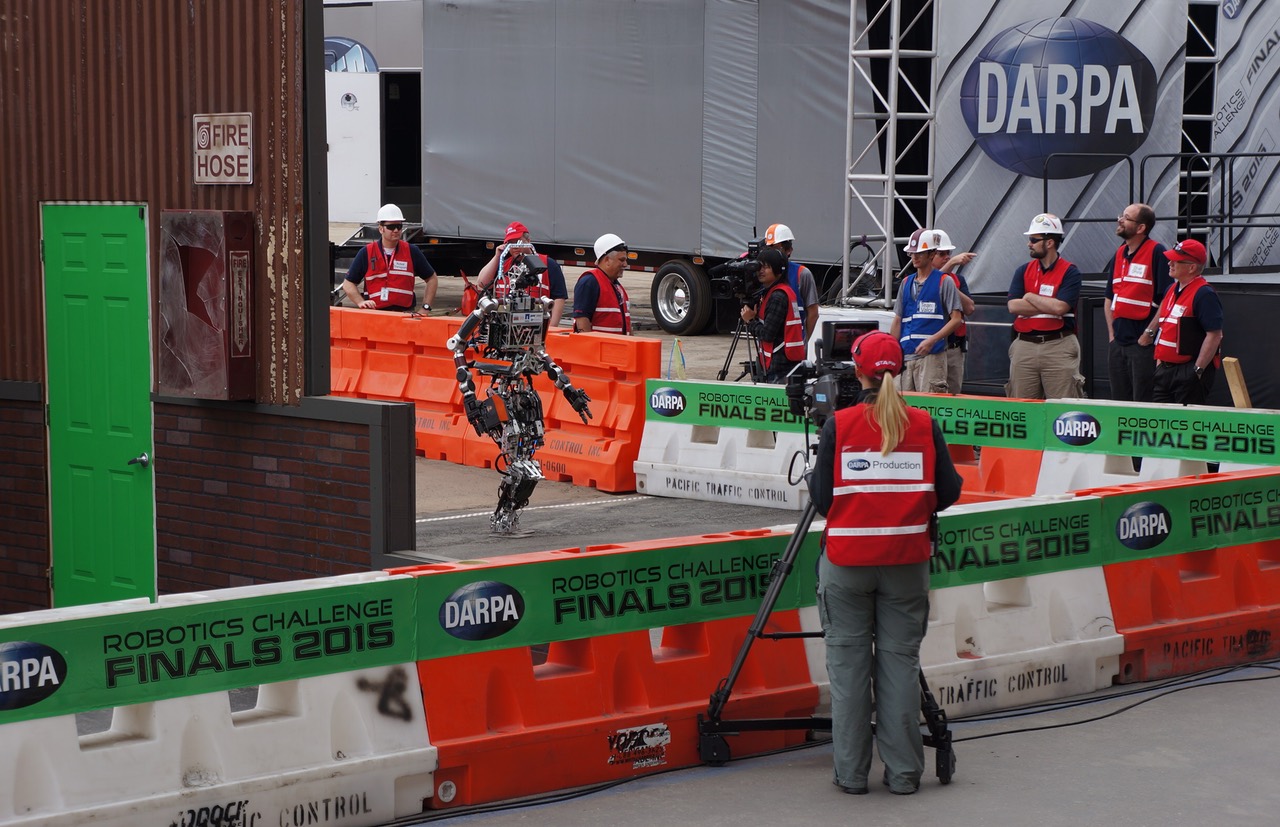
The event just started, but I’m already wandering the fairgrounds aimlessly trying to find something to hold my attention. The robots are struggling to perform effectively and the jokes everywhere are all the same: I guess these robots won’t be taking over the world any time soon! DARPA? More like DERPA! Just look at that million dollar robot fall on its arse! Or, I guess, the part of the robot that would be its arse if it needed an arse.
Robots falling over is funny, but fixating on their current inadequacies obfuscates the reality of what we’re witnessing. These are the great-grandparents of the robots that really will be taking over our world one day. And I don’t mean that in some hyperbolic, fearmongering way. They will simply be in our homes, on our streets, and yes, on our battlefields. In some ways they already are. The age of humanoid robotics really is upon us. The US military would not be spending money to advance the science if it weren’t.
And we have some hard questions to ask ourselves between now and that time in the future when Grandpappy Atlas tells tales of what happened this weekend in Pomona. Although we’re currently awash in robot fail gifs, we have to remind ourselves that DARPA’s explicit mission is to develop technologies for national defence.
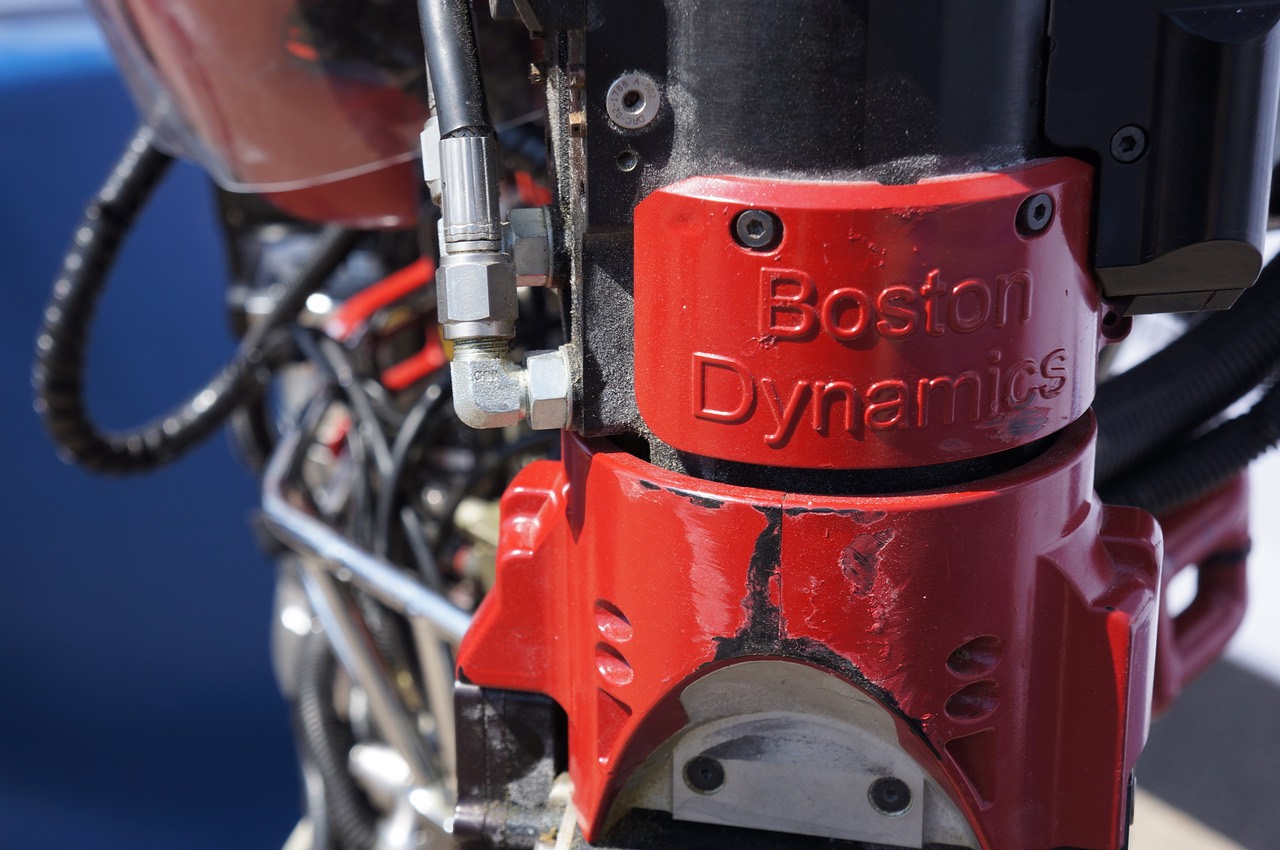
The future smells like horseshit. I’m trying to not let it get to me as the distinct odor of manure wafts through the northernmost section of the stands. These fairgrounds are sometimes used for horse racing — hence, the smell. I’m just standing here in one of the the press boxes waiting for a robot to open a door and walk over the threshold. It turns out I’m going to be waiting for a while.
These robots are attempting basic physical tasks that most adult humans would find easy. For a shot at the top prize of $US2 million, each team must get their robot to complete eight tasks in total, with each task worth just one point.
First the robot has to drive a vehicle about 100 yards. Which seems difficult enough, but the second part poses the greater challenge. It has to exit the vehicle, and that’s really no easy task. Thirdly it has to open a door and walk through it. Once the robot does that, the DARPA organisers introduce disruptions in wireless communications between the teams and their bots.
The entire challenge is meant to simulate a hazardous situation for humans like the nuclear disaster in Fukushima in 2011. The communications disruptions are an extension of that simulation because wireless and emergency networks would be overloaded or down in a real disaster. Now, the robot must close a valve by rotating it 360 degrees. For its fifth task, the robot must pick up one of four drills and drill a large hole in a wall. Sixth, there’s a surprise task like pulling a lever or unplugging and replugging something. Seventh, the robot must traverse an area with uneven cinder blocks, or move rubble to make its way to the far side of the course. And last but not least, the robot must climb some stairs. The competitors have one hour to complete all eight tasks.
Four courses are set up in front of the stands so that multiple teams can go at a time. And it looks like I chose the wrong course. The robots, including the HRP2 from Tokyo that I’m currently watching stand frozen in front of a door, can’t smell the shit. But the humans in this section of the stands can’t escape from it.
I start scribbling notes in my notepad so that I don’t get tempted to check my phone. Gotta focus. It’s like watching the future unfold in slow motion. Painfully slow.
10:15am: Still waiting on the Japanese team. They’re talking with staff at DARPA about something.
10:17am: I told myself I’d stick with this. Gotta stick with this.
10:18am: Oh, we have movement. Their robot has been hanging from some contraption. Looks like movement?
The boredom is really starting to get to me. I’m the worst.
10:24am: Checking Twitter and fiddling with my phone. Politics, dinosaurs, politics, Mindy Project, sick burn from John Cleese, economy, Snowden, a man legally changing his name to avoid getting an airline booking error fee. I should check on that. Can’t be bothered to click, but I don’t believe it. Maybe something to debunk in the future. Maybe not. The world is filled with weirdos. It’s also filled with clickbait. OK, focus up.
10:27am: The Japanese team is still standing there. One guy looks kinda pissed with his hands on his hips.

The jumbotrons above the courses cut to an interview with the DARPA director, Arati Prabhakar. Every time I’ve heard her speak, she touts the consumer side of the tech they have developed at DARPA. GPS, the internet… man, DARPA loves to talk about how they invented the internet. Which makes sense. They should be damn proud. But DARPA was doing a lot of other shit in the late 1960s. I wonder if Project AGILE had any dual use technologies that came out of it.
10:33am: This is painful.
10:38am: They have gotta be close to the one hour time limit. Come on HRP2.
10:39am: Some cheering coming from two doors down. Baby steps on the jumbotron. The Running Man became the leader in points as it baby steps into a yellow box. Two points.
10:50am: Made my way over to IHMC Robotics and their Running Man robot. Running Man has made it through the door and is reaching for the drill. Well, sort of. Running Man dropped the drill. A “Nooo…” ripples through the stands.
10:54am: Looks like he’s got a handle on another drill.
10:56am: The track next door has a robot that’s struggling to get out of the vehicle. It’s lying on its back across both seats and its hands are up as if in terror. I can’t help but anthropomorphize it. Man, I would have way too much empathy in the robot uprising.
10:58am: Running Man is drilling his hole.
10:59am: Cheering as it looks like he’s doing well on that 1/2 inch thick drywall. Uses the butt of the drill to push the hole out successfully. Thunderous applause.
11:01am: The robot sets the drill down, more applause.

As the robot moves slowly I catch part of a conversation happening next to me. “…does it ever give you pause?” a woman asks. “Any technology can be militarised,” the guy replies. “I can’t speak for DARPA…” the man continues.
11:06am: Wait, what was the surprise task? I think I missed the surprise task because it happened so slowly. Is that possible?
11:07am: Applause as he steps onto a pile of cinder blocks. Why am I calling it “he”?
11:08am: Groans as he falls awkwardly backwards. Then applause. “They were so close, man,” someone says in the crowd.
11:10am: A team of five in blue vests and white hard hats arrive to collect their fallen comrade.
11:25am: Running Man resets and walks toward the door. He has six points. Doesn’t need to redo the tasks he’s already done.
11:29am: Running Man trying the obstacles again and doing a fair job.
11:30am: Slowly but surely… Image sensors swirl on Running Man’s head. Applause as he clears the last of the rubble. More applause as he confidently walks towards the exit door and approaches the stairs. Can a robot be confident?
11:32am: Running Man raises his left hand, crouches, small shuffling steps toward the stairs. Puts one foot up, waivers, wobbles for maybe five seconds… and… falls backward. That’s it for Running Man.
I’ve been up since 5am and haven’t had anything to eat. I should go do that.
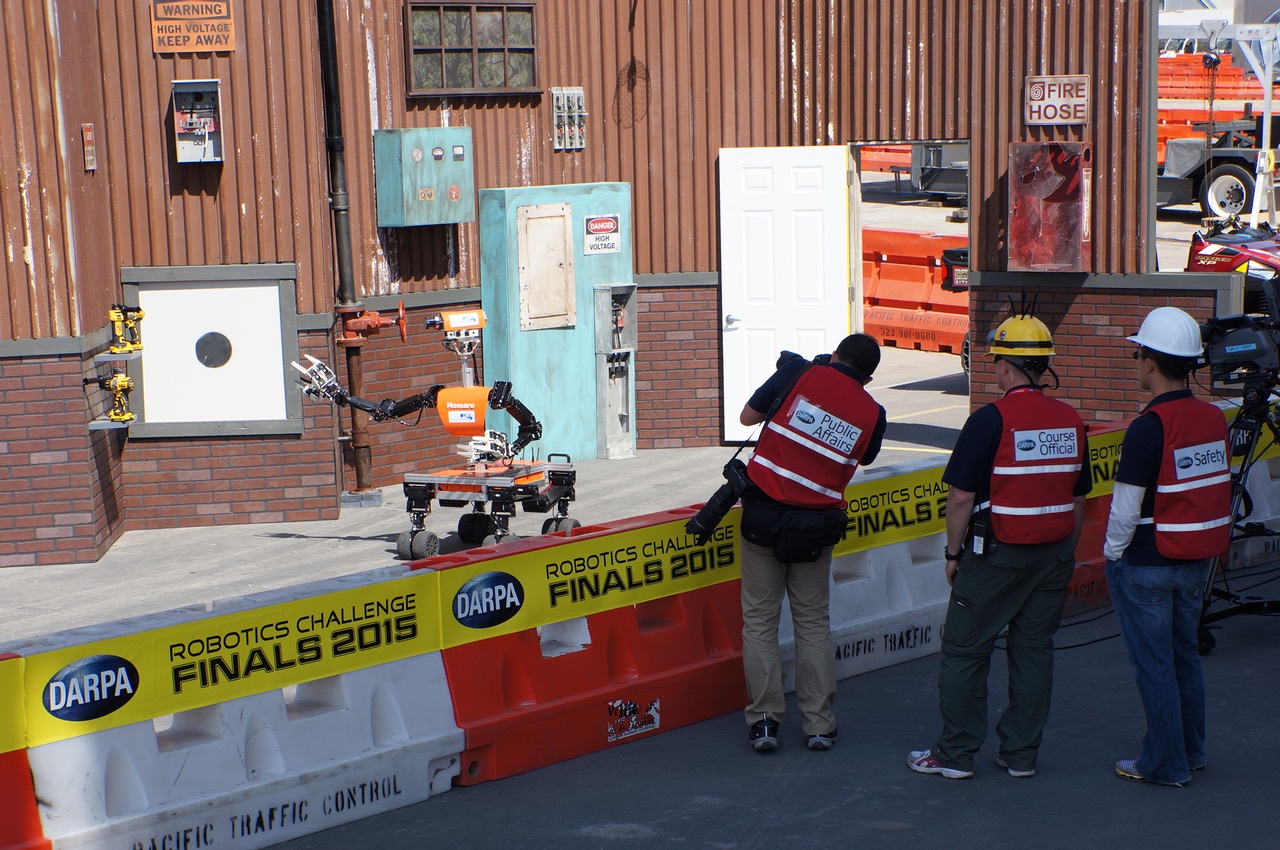
If DARPA has an interest in any particular technology, there’s a reasonable chance that it will be a practical reality within your lifetime. DARPA specialises in “high risk, high reward” research and development, which means that it’s pushing the limits of what’s possible. But DARPA isn’t interested in dicking around with impractical nonsense. Or anything that doesn’t have applications that contribute to national defence. “Here at DARPA we don’t do science for science’s sake,” Steven Walker, deputy director of DARPA, says in a video at the expo. Walker goes on to explain that one of the reasons DARPA was created was to create “technological surprise.”
The agency was founded in 1958 (then known as ARPA) on the heels of the Soviet Union’s successful launch of Sputnik, the first artificial satellite, into orbit. It was a national embarrassment for the United States — especially the Cold Warriors who insisted that American style capitalism would produce the best goods, services, and technologies. So the Eisenhower administration decided that it wouldn’t be surprised again.
Just one of many technologies developed by DARPA is the driverless car. Americans have been waiting on the fully automated driverless car for decades. In fact, scifi visions of the driverless car are nearly as old as the automobile itself. And with each passing day, we inch closer and closer to driverless cars becoming a mainstream reality on America’s roads.
Today we associate companies like Google with driverless car development. But DARPA has been working on driverless cars since before Google even existed. If you mention DARPA and driverless cars, most people will think of the DARPA Grand Challenges of 2004, 2005 and 2007. Much like the Robotics Challenge, the goal was to invite the academic and private R&D communities to compete for prize money and move the technology forward. What fewer people might remember is that DARPA developed driverless cars in the mid-1980s. Reagan’s Strategic Defence Initiative (derided by critics as Star Wars) had a little-remembered sister program called the Strategic Computing Initiative. Darpa was basically trying to create a real-life Skynet, and one component of the program was a driverless car developed by Martin Marietta, now part of Lockheed Martin. The tech was primitive, and they may not have achieved their goal of creating Skynet, but they gave it a shot.
I spend the rest of the afternoon wandering between each course watching the different robots. At one point a robot picks up a drill, which draws scattered applause. Some people shout “Drill, baby, drill!” at the robot, which as far as I can tell, can’t hear them. A minute later the robot drops the drill. Such is the robot’s way.
Throughout the day I watch robots from some of the smartest people in the world compete. Teams from NASA’s Jet Propulsion Laboratory, MIT and a South Korean team called Kaist all perform admirably, if admittedly slow. In the early evening a robot called CHIMP falls flat on his face after getting through the door, but then something amazing happens. He gets up. Most teams take the 10 minute penalty and reset their robot after it falls. But CHIMP just picked himself right up. Thereafter the announcer dubs CHIMP a fan favourite, which probably wasn’t wrong, but of course he’d polled precisely zero people to make this claim.
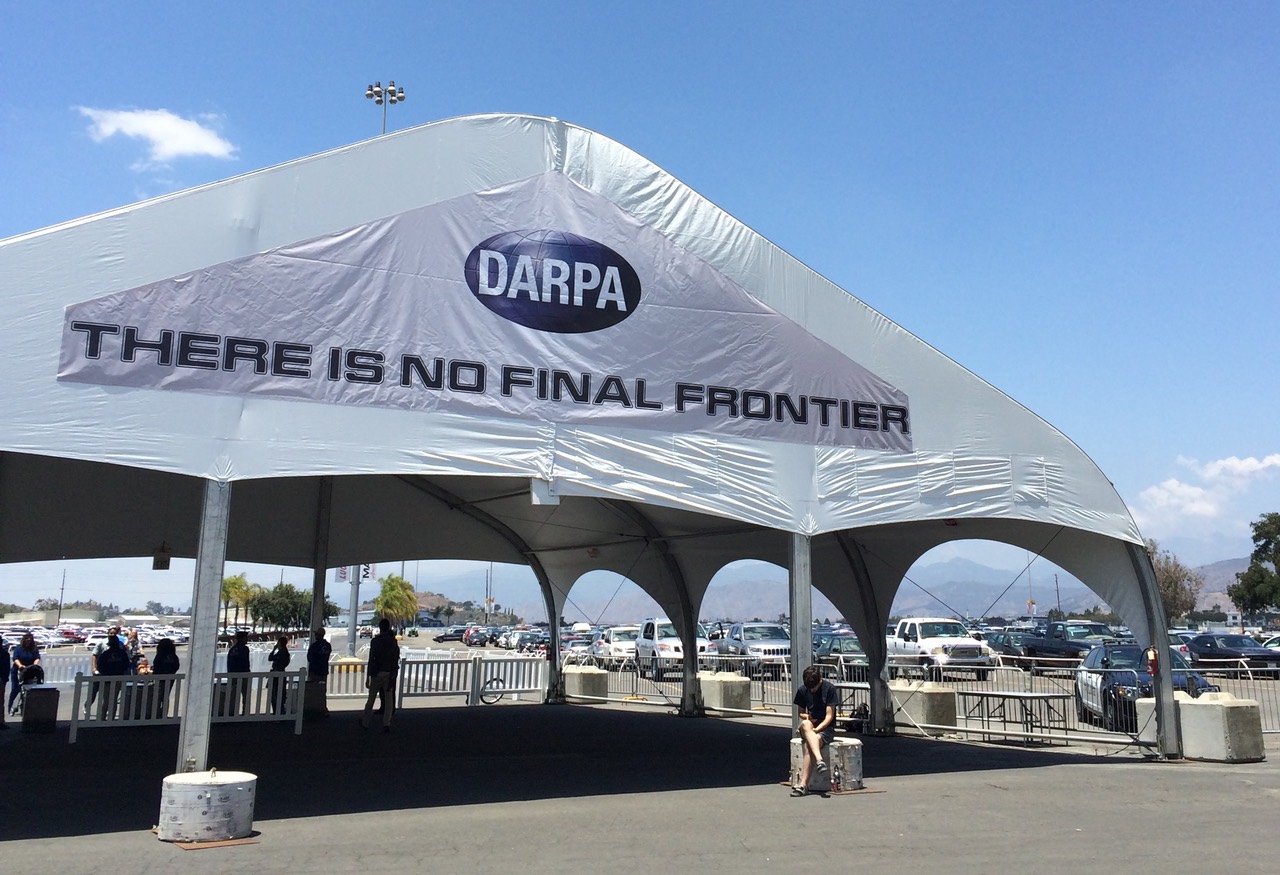
As I’m leaving for the day I can’t help but wonder what other technologies DARPA has up its sleeve — the classified ones that would presumably make so much of this competition moot. Maybe there’s a vision system that would completely revolutionise the field. Maybe there’s a magic bit of code that could make the robots do somersaults while singing the Star Spangled Banner. I don’t know. But I guess that’s the point. DARPA is very proud of its successes, but the public doesn’t even know the half of it. Some of its projects from the 20th century are still classified. As a result, DARPA sometimes actually hinders the very research it claims to support.
Take the case of adaptive optics and the laser guide star. In the early 1980s, researchers funded by DARPA were working on technology for telescopes that correct for the distortion caused by the atmosphere. The military wanted to be able to find and destroy any potential missiles being launched from the Soviet Union. By 1983 they’d solved the problem. But because the project had been consolidated into Reagan’s Strategic Defence Initiative the optics tech stayed classified for nearly a decade. When astronomers finally learned about it in 1991, many were angry. Ann Finkbeiner recounts the story in her fascinating book from 2006 called The Jasons: The Secret History of Science’s Postwar Elite. “I think it is not an exaggeration to say that the secrecy held up progress in adaptive optics for ten years,” Finkbeiner quotes physicist Freeman Dyson as saying.
The American military has always leaned on universities and private industry to produce the most advanced technologies for national security. But innovation in the broadest sense still struggles when technology developed by DARPA remains classified. And it frustrates me as I wonder about the secret research that might help these teams, or perhaps more optimistically, help humanity as a whole.
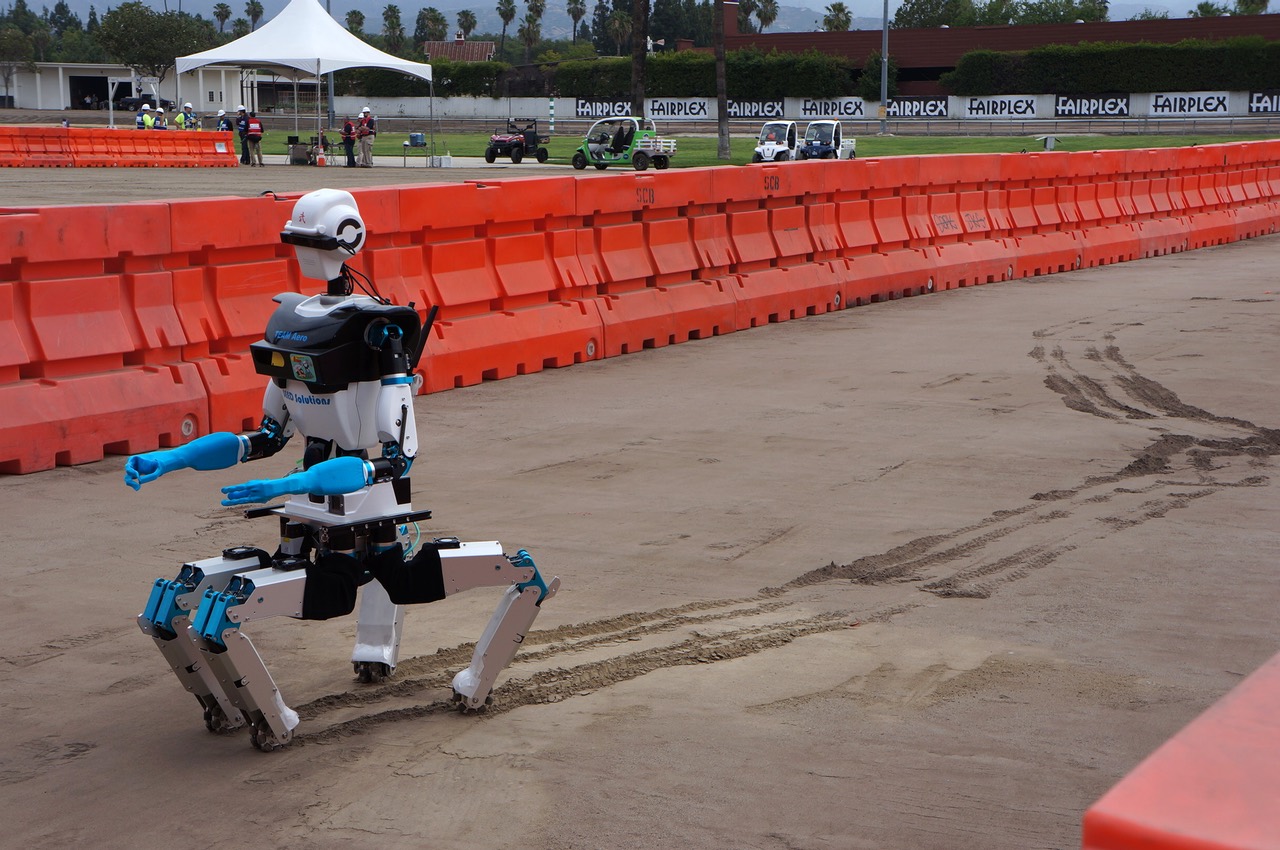
The second day is off to a slow start, not unlike the first. Still lots of robot falls, which seemed to be a highlight for the internet yesterday. Why are robots so funny when they fall over? I guess it’s because so many seem to freeze before it happens. And nobody puts out a hand to break their fall in any way. They topple like statues. I guess some people also find comfort in the fact that the robot revolution is still a ways off. Laugh now, puny humans. Those robot-fail gifs are going to look less silly with each passing year. But they’re certainly popular.
Vox: Watch the world’s most advanced humanoid robots fall down
Popular Mechanics: The most hilarious robo-falls from the DARPA Robotics Challenge
The Verge: High-tech robots falling down is the funniest thing you’ll see all weekend
I wonder what fail gifs of other groundbreaking technologies in history would look like. The ARPANET’s first host-to-host connection famously failed on October 29, 1969 trying to connect from UCLA to Stanford. Researchers were trying to type “LOGIN” but only managed to get LO off before it crashed.
LOL PROTO-INTERNET FAIL.
14 LIGHTBULB GIFS THAT SHOW WHY ELECTRIC LIGHT IS NEVER GONNA HAPPEN.
28 REASONS HOMO ERECTUS SHOULDN’T GET TOO EXCITED ABOUT GROK’S FIRE JUST YET.
A hundred years ago, the Pomona Fairplex where we are today was just a field of barley and beets. A hundred years before that, it was a plot in what was then Mexico. The exciting thing about futurism is that literally nobody knows what the next 100 years holds. But if the offspring of the robots at this competition aren’t reasonably mistaken for human beings, I’ll eat my smartphone. Or at least I would if I weren’t rotting the ground. That’s the other neat thing about futurism — futurists are usually dead before their predictions can be called a failure.

I spend the morning walking between the main competition area and the expo grounds, investigating the booths from DARPA, different universities, the Navy, 3D printer companies, and even a bible college that’s promoting its program on the ethics of emerging technologies.
“We believe that we must consciously push back against the erroneous assumption in our society that change is progress,” a pamphlet from the Southern Evangelical Seminary and Bible College reads. “Sometimes it is, sometime [sic] it isn’t, and often it is progress with significant trade-offs and consequences that should at the very least be examined and explored before plunging blindly ahead, regardless of any possible collateral damage.”
I find myself strangely agreeing with the message on its surface. But I can read between the lines. What kind of changes are you really referring to, Southern Evangelical Seminary and Bible College?
The DARPA-sponsored signs at the expo advertise the history of agency. But much like an online dating profile, they mostly give us a distorted and positive view. The ARPANET and GPS and improvements in radar are all there. Operation Igloo White and the invention of the electronic battlefield? Not so much.
I spot another sign towering above the growing crowd of people at the expo: “If I had asked people what they wanted, they would have asked for a better horse. – Henry Ford.”
Coming from DARPA, this too almost sounds like a threat. We’re not here to give you want you asked for. We know better. We know what the world needs. I guess it makes sense when you’re talking about consumer goods. But when the most innovative agency in the nation tasked with killing people is saying it, the message is decidedly more creepy.

My planned interview time with DARPA program manager Dr. Gill Pratt has been delayed a couple of times today, but we finally talk briefly in the mid-afternoon. Pratt is an incredibly likable guy. Earnest and focused, he’s the reason that this competition came together. And it’s been a long time in the making. About twenty years ago as a junior professor Pratt had an unrelated meeting with DARPA where he pitched them his idea.
“My idea at the time was, let’s have legged robots go up Mount Washington, which is a beautiful climbing route in the Northeast,” Pratt tells me. “And what’s neat about Mount Washington is that there’s a road that goes up too. So if you want to do it the easy way, you have them go up the road, but the hard way of course is to go up the hiking trails. I had this kind of neat dream, like let’s have robots go up on hiking trails.”
The people at the meeting were taken aback. One didn’t just pitch an idea like that, at least in the meeting he was attending as a junior professor. So they encouraged him to think about becoming a program manager for DARPA one day so that he could execute this vision. And here he is, twenty years later, doing exactly that.
So far I’ve asked two different DARPA officials why the Chinese team dropped out. And nobody will talk with me about it on the record. But Pratt doesn’t shy away from the question, nor the sensitivities around national security when we effectively have a new Cold War brewing with countries like Russia and yes, China. He says that the competitions are organised around “humanitarian assistance and disaster relief,” which means the contest can be “blind” to the “politics going on between the countries.”
And yet, he explains:
There are certain laws in the United States — with a small amount of countries that we’re not allowed to do business with, they’re terrorist countries, right? So we couldn’t allow them. But we allowed every single other one, regardless of whether they were an ally or a competitor of the US.
So we have a team from Hong Kong. We had had an entry from the People’s Republic of China. They decided to withdraw. They told us the reasons for that, they were completely understandable. Nothing to do with politics that might exist between one country and the other.

So I still don’t know the real reason China dropped out.
I bounce between courses again, watching. More “ohhhs” from the audience as robots fall on their robot asses. And roaring applause when they succeed at their basic tasks. Some robots have even taken to showing off. After Running Man is finished ascending the staircase, it raises its hands in triumph. The crowd erupts in cheers and high-fives. Hilariously, the robot then proceeds to fall over. Not so cocky now, huh robot?
I start daydreaming about what a competition like this might look like in ten years. Will the robots be advanced enough that they might compete against a human? Will the humans be part of the tasks? Maybe a task of the year 2025 will include making a human cry using only insults. Forget strapping machine guns to these things, a robot that could get inside a human’s head and give him or her low self-esteem would be one hell of an offensive capability.
Unsurprisingly, the closing ceremonies included a comedic video of robots falling down. The whole thing has that “be not afraid” vibe to it again, much like the media briefings and the countless OMG THEY FELL OVER blog posts. The South Korean team, Team Kaist, has taken home the $US2 million first prize, after scoring a perfect 8 points in just 44 minutes and 28 seconds. Third prize went to “fan favourite” CHIMP. Second prize went to IHMC Robotics’ Running Man, that robot who fell over while celebrating a little too hard.
I get excited for all the teams as they celebrate their wins in front of the main stage. They have all created something beautiful in a shitty, ugly world. And since I didn’t see a single time traveller in the crowd attempting to sabotage the robots and screaming “MAYBE IT’S NOT TOO LATE” I just let the techno-utopian joy wash over me.
Technology begets technology. I don’t understand it any better than when I first arrived in Pomona. Is technology for its own sake some kind of endgame?
The cheery, tautological slogan doesn’t really work when you start to think about worst case scenarios. If that specific technology is something like nuclear weapons dropped on every major city in the world, then no, technology does not beget technology. Technology ends lives and ruins industries and starves communities.
As yet another DARPA sign says, “There is no final frontier.” But when the military starts building humanoid robot soldiers, even techno-optimists may start wishing that the end was in sight.
